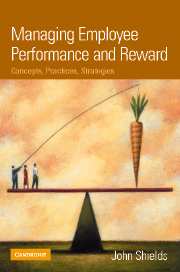Book contents
- Frontmatter
- Contents
- List of figures and tables
- Foreword by John Egan
- Acknowledgements
- Introduction: Setting the scene
- Part 1 The fundamentals
- Part 2 Performance management in action
- Part 3 Base pay and benefits
- Part 4 Rewarding employee performance
- 14 Overview of performance-related rewards
- 15 Merit pay for individual performance
- 16 Recognition awards
- 17 Results-based individual incentives
- 18 Collective short-term incentives
- 19 Collective long-term incentives
- 20 Executive incentives
- Case study. Beyond the hard sell: Performance incentives at Southbank
- Part 5 Fitting it all together
- Model responses to case studies
- References
- Index
14 - Overview of performance-related rewards
from Part 4 - Rewarding employee performance
- Frontmatter
- Contents
- List of figures and tables
- Foreword by John Egan
- Acknowledgements
- Introduction: Setting the scene
- Part 1 The fundamentals
- Part 2 Performance management in action
- Part 3 Base pay and benefits
- Part 4 Rewarding employee performance
- 14 Overview of performance-related rewards
- 15 Merit pay for individual performance
- 16 Recognition awards
- 17 Results-based individual incentives
- 18 Collective short-term incentives
- 19 Collective long-term incentives
- 20 Executive incentives
- Case study. Beyond the hard sell: Performance incentives at Southbank
- Part 5 Fitting it all together
- Model responses to case studies
- References
- Index
Summary
As we have seen, there is considerable debate about the link between money and other types of extrinsic reward on the one hand and employee satisfaction, motivation, work effort and performance on the other. By way of introduction to part 4, this chapter identifies the main categories and types of performance-related reward, and considers some of the general motives for adopting performance-contingent rewards, as well as examining the evidence on the incidence of the main types of performance-related reward plans, particularly cash incentives or performance-related pay. The chapter also overviews the main arguments and supporting evidence for and against such plans, taking into account both effectiveness and felt-fairness.
What is performance-related pay?
All forms of paid employment, including those where remuneration consists entirely of base pay, have performance standards or expectations of some sort attached to them. As Behrend (1957, 1961) and others have suggested, every form of paid employment involves an effort bargain as well as a pay bargain. In some cases, this will involve a set of implicit mutual expectations – à la a psychological contract – between employee and employer about a pay–effort deal – about the basis of ‘a fair day's pay for a fair day's work’. In other cases, it might entail the imposition of specific task quotas for each unit of hiring time. This is the case with the practice known as ‘measured day work’, whereby employees receive a fixed daily wage but are required to work to a standard output quota.
- Type
- Chapter
- Information
- Managing Employee Performance and RewardConcepts, Practices, Strategies, pp. 347 - 368Publisher: Cambridge University PressPrint publication year: 2007

